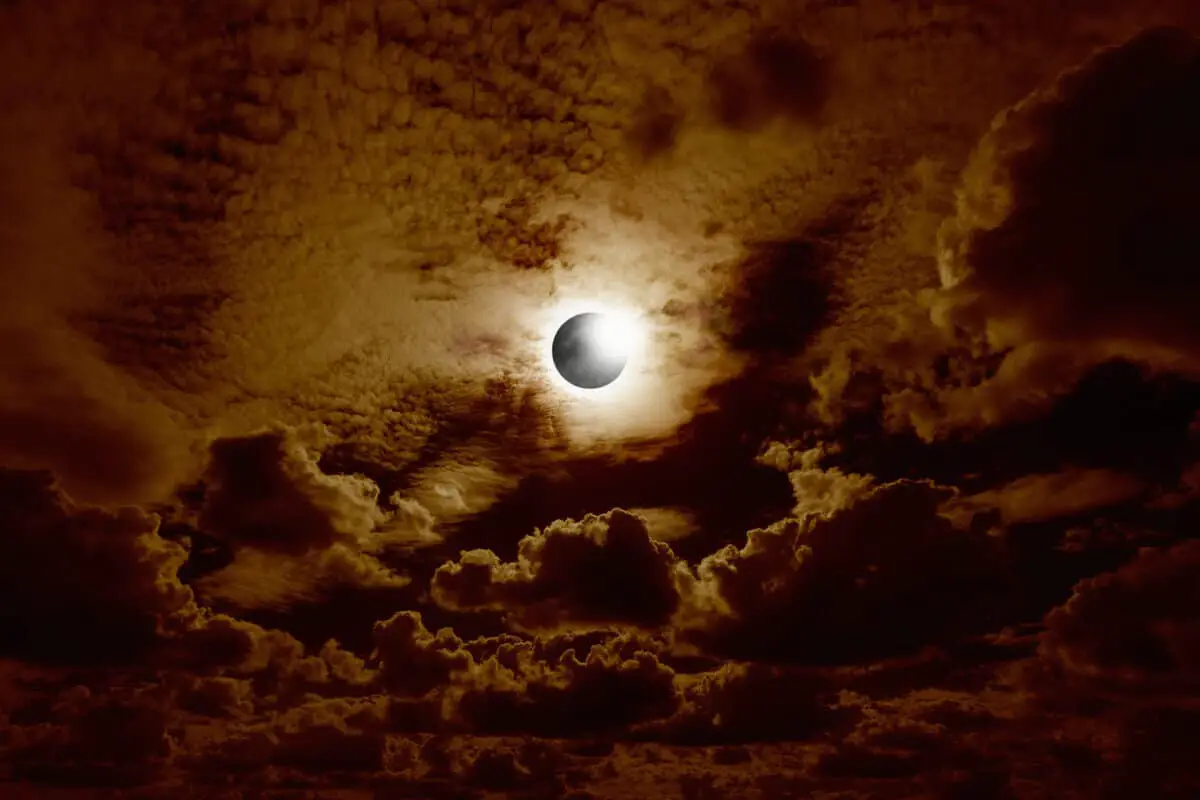Fancy watching the eclipse in one of the most spectacular settings on Earth? Banff National Park is a prime spot to witness this natural phenomenon! In this guide, you’ll find everything you need to know to experience the eclipse in the park.
The upcoming (partial) solar eclipse in Banff on October 14, 2023, is a rare opportunity to witness this fantastic experience created as the moon passes before the sun. It casts a spectacular shadow on the Earth.
Banff National Park has several prime viewing spots to watch this awe-inspiring event. Below you’ll find all the information you need to make the most of the (partial) eclipse.
Let’s dive in!
Why Watch a Solar Eclipse in Banff National Park?
Watching a solar eclipse is rare, and choosing the perfect location to witness this celestial spectacle can significantly enhance your experience.
Just imagine yourself standing at gorgeous Lake Louise with the Victoria Glacier in the background when watching the eclipse. Or Vermilion Lakes with spectacular Mount Rundle in the distance.
Sounds convincing? Banff National Park in Canada simply offers a unique and stunning setting to observe a solar eclipse.
What Is a Solar Eclipse?
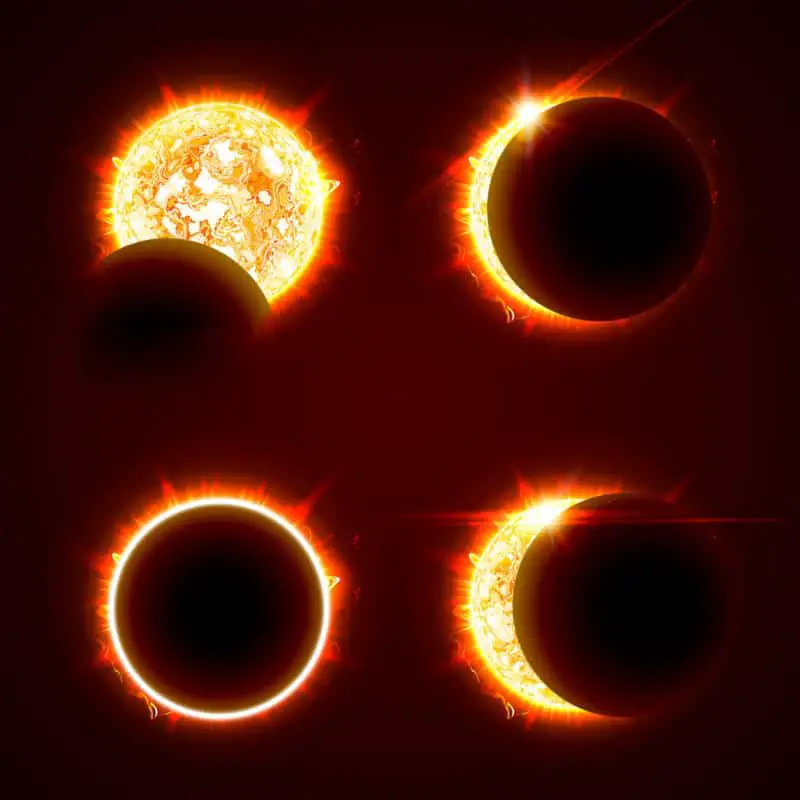
A solar eclipse occurs when the moon passes precisely between the Earth and the sun, casting a shadow on the Earth’s surface. There are two main types of solar eclipses: partial solar eclipses and total solar eclipses.
During a partial solar eclipse, the moon blocks only a portion of the sun’s light. In contrast, a total solar eclipse completely blocks the sun’s light, creating a spectacular moment of darkness in the sky1.
Viewing a solar eclipse can be an incredible experience, especially in a beautiful and natural setting like Banff National Park.
However, it’s essential to protect your eyes during a solar eclipse. Never look directly at the sun without proper eye protection, such as solar viewing glasses or solar filters for telescopes or binoculars.
It’s good to know that regular sunglasses are NOT enough to protect your eyes from the sun’s harmful rays.
There are two solar eclipses every year. Whether or not you can see one depends on where you are on the planet.
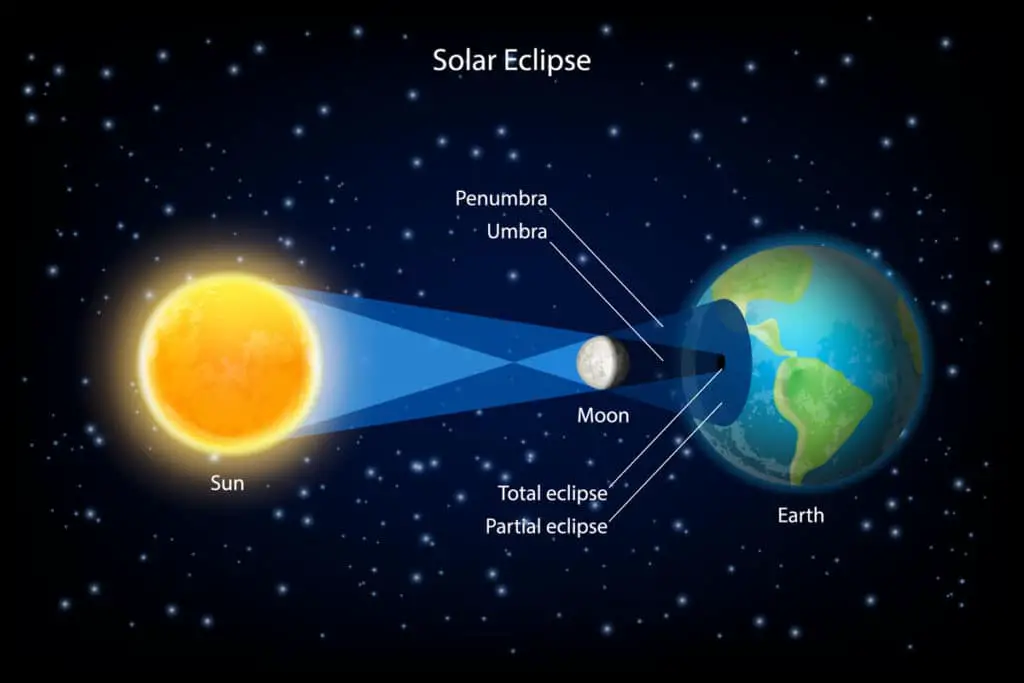
The Solar Eclipse at Banff National Park
Eclipse Date and Time
Mark your calendar for a unique celestial event on October 14, 2023! Banff National Park will be the perfect spot to witness an annular solar eclipse that day.
The eclipse will begin at 10.25 am. You’ll see the moon pass before the sun. Grab the best viewing spot in the park and have your solar glasses on.
Prime Viewing Spots
While there are countless spectacular places to view the (partial) solar eclipse in Banff, I have highlighted four of the best spots below to help you know where to go.
As these are some of the most visited spots in the park, you’ll want to read about visiting these places to know how to get there and what to expect. I have included a link to the guides I have written about these places in the park.
Lake Louise
Lake Louise is probably the most popular spot for viewing natural phenomena in Banff National Park. It provides wide-open skies, ideal for watching the solar eclipse and a stunning backdrop with the lake, the surrounding mountains, and the Victoria Glacier at the other end of the lake.
Be ready to share the space with other visitors. The lake is almost always (very) busy.
Also read: everything you need to know about visiting Lake Louise
Moraine Lake
Another stunning place to view the eclipse is Moraine Lake. The lake is surrounded by the Valley of the Ten Peaks, providing a stunning backdrop for the eclipse.
The rock pile on the lakeshore is a prominent spot to view the event. Be aware that you won’t be the only one using this vantage point. So get there early to secure your spot.
Good to know: Getting to Moraine Lake is a bit of a hassle as the road to the lake is closed to most vehicles. The only way to get there is by shuttle bus.
CAVEAT: If the eclipse is before May or after Mid-October the road to the lake is closed due to avalanche danger.
Also read: the guide to Moraine Lake
Vermilion Lakes
The Vermilion Lakes, a series of three lakes just west of the town of Banff, is a picturesque spot to view the eclipse. The serene atmosphere and reflections on the water make for a unique experience.
Mount Rundle in the background makes it extra spectacular, if you ask me.
Don’t forget to bring a blanket or chair to make your eclipse viewing experience more comfortable. You can sit on one of the jetties on the lakes, right on the water’s edge, which makes it extra special.
Also read: all you need to know about visiting Vermilion Lakes
Peyto Lake
Peyto Lake’s distinctive turquoise color provides a striking contrast to the solar eclipse. You’ll need to hike for about ten minutes from the Peyto Lake parking lot to get to the viewing platform.
There you’ll find an excellent elevated vantage point, allowing you to enjoy the eclipse to the max.
Peyto Lake is a very popular tourist destination, so be prepared for crowds and pack your patience.
Also read: all you need to know about visiting Peyto Lake
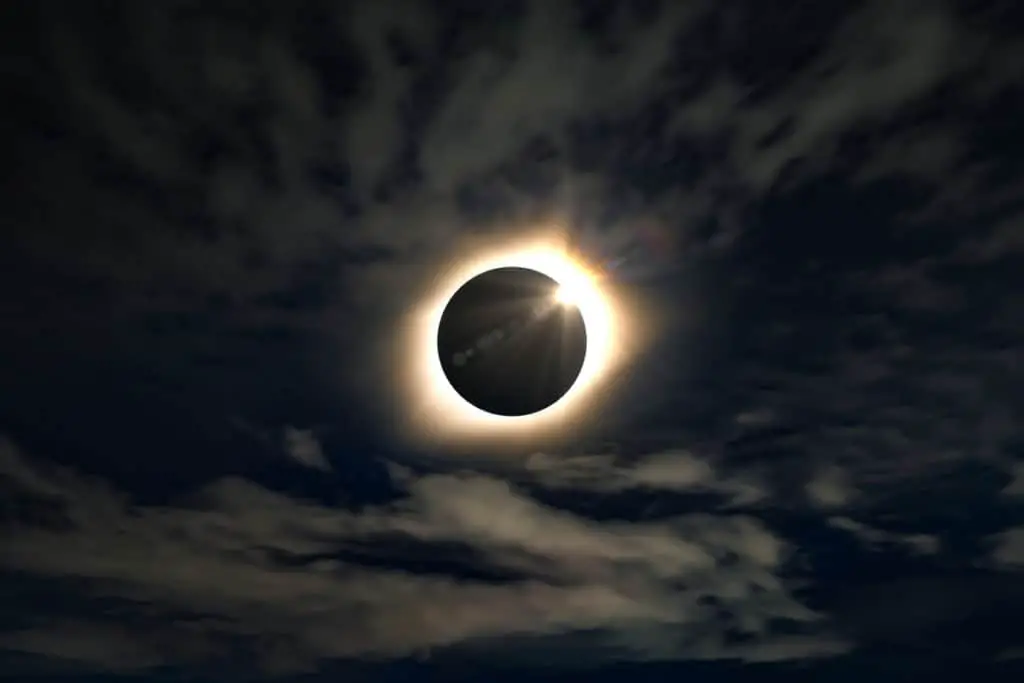
The Best Time to View the Solar Eclipse in Banff
If you plan to experience the solar eclipse in Banff National Park, you’ll want to mark your calendar for October 14, 2023. The Annular Solar Eclipse will take place on this date, although it will be a partial eclipse in Banff.
The solar eclipse will start at around 10:25 am. Visibility will depend on the weather conditions and where you are in the park.
Choose a spot with a clear sky view to increase your chances of witnessing the natural phenomenon. You may want to arrive well before the start time to set up your viewing equipment and secure a suitable viewing spot.
Make sure you come with a pair of solar viewing glasses or a pinhole projector to ensure your eyes are safe during the event.
Future Solar Eclipses in Banff National Park
To ensure you’re informed of the next solar eclipse visible in Banff National Park, I put all the upcoming eclipses for the rest of the century in the table below. That should have you covered!
| DAY | MONTH | YEAR | TYPE OF ECLIPSE |
|---|---|---|---|
| Saturday 14 | October | 2023 | Partial |
| Monday 8 | April | 2024 | Partial |
| Wednesday 12 | August | 2026 | Partial |
| Sunday 14 | January | 2029 | Partial |
| Wednesday 30 | March | 2033 | Partial |
| Tuesday 21 | June | 2039 | Partial |
| Sunday 4 | November | 2040 | Partial |
| Thursday 9 | April | 2043 | Partial |
| Monday 22 | August | 2044 | TOTAL |
| Saturday 12 | August | 2045 | Partial |
| Monday 5 | February | 2046 | Partial |
| Thursday 11 | June | 2048 | Partial |
| Saturday 30 | March | 2052 | Partial |
| Tuesday 1 | September | 2054 | Partial |
| Wednesday 27 | January | 2055 | Partial |
| Sunday 16 | January | 2056 | Partial |
| Wednesday 12 | July | 2056 | Partial |
| Sunday 1 | July | 2057 | Partial |
| Tuesday 22 | June | 2066 | Partial |
| Saturday 11 | June | 2067 | Partial |
| Saturday 24 | November | 2068 | Partial |
| Wednesday 23 | September | 2071 | Partial |
| Monday 15 | November | 2077 | Partial |
| Wednesday 11 | May | 2078 | Partial |
| Tuesday 16 | February | 2083 | Partial |
| Sunday 2 | July | 2084 | Partial |
| Sunday 16 | December | 2085 | Partial |
| Friday 2 | May | 2087 | Partial |
| Saturday 23 | September | 2090 | Partial |
| Thursday 23 | July | 2093 | Partial |
| Monday 12 | July | 2094 | Partial |
| Tuesday 7 | December | 2094 | Partial |
| Monday 21 | May | 2096 | Partial |
| Saturday 11 | May | 2097 | Partial |
| Wednesday 24 | September | 2098 | Partial |
| Monday 14 | September | 2099 | TOTAL |
| Wednesday 10 | March | 2100 | Partial |
The table shows that only two total solar eclipses will be visible in Banff National Park this century. The first is on Monday, August 22, 2044. The second will be on Monday, September 14, 2099.
So you’ll have to be patient to see a total solar eclipse in Banff.
It’s also worth noting that in 2056 and 2094, you’ll be able to see a partial eclipse twice in the same year.
The months of July and September top the list for eclipse frequency. These months will see (partial) eclipses five times this century.
Planning Your Trip
Accommodations
When planning your stay in Banff National Park during the solar eclipse, it’s essential to book your accommodations well in advance due to the high demand of visitors.
Numerous lodging options are available, ranging from luxurious hotels to cozy bed and breakfasts. Some popular choices for accommodation in the park include the Fairmont Banff Springs, Banff Park Lodge, and the Mount Royal Hotel.
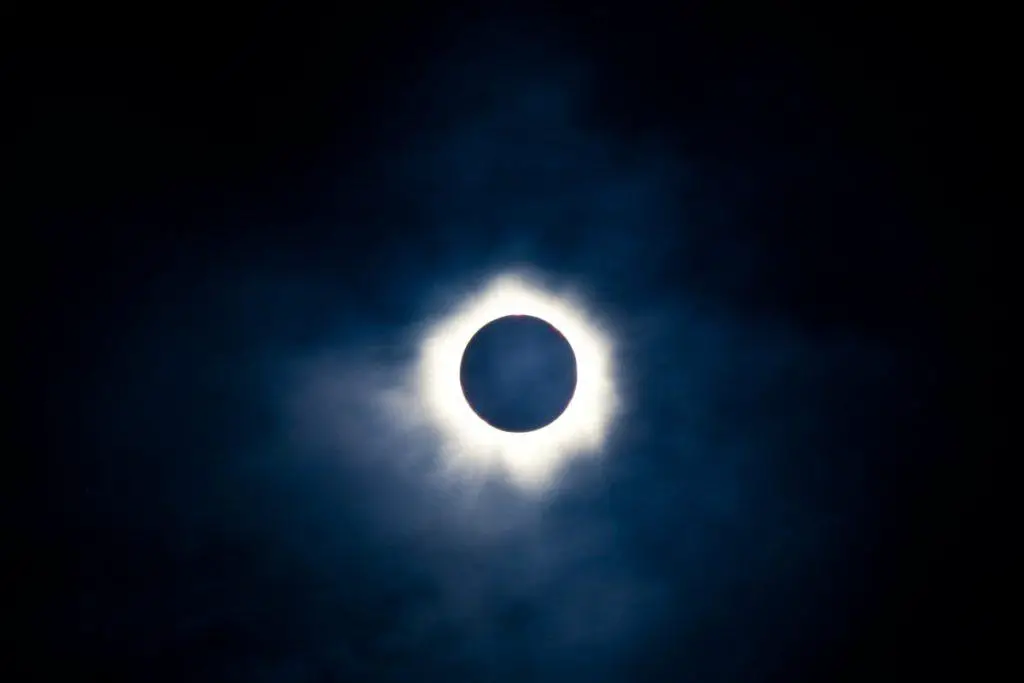
Transportation
By far the easiest way of getting around Banff National Park is by car. But know that parking can be limited during peak season. The days surrounding a solar eclipse are also quite busy as many people flock to the park to witness the event.
If you plan to watch the eclipse at Moraine Lake or Lake Louise, plan your trip well (see above) to avoid disappointment.
You can also hop on a Roam Public Transit bus connecting Banff and Lake Louise. Their schedule is pretty good and takes you to several famous locations in the park, including Moraine Lake and Lake Louise.
You can also take a taxi. There are also two taxi services in Banff.
- Banff Taxi (+1 403 – 762 4444)
- Taxi Taxi (+1 403 – 762 0000)
Both are available 24/7. Transportation of (larger) groups is also possible. Be aware that service is relatively limited and that prices are very high.
Permits and Fees
You’ll need a National Park Pass to visit Banff. Pricing can vary based on the duration of your visit and group size. Be sure to purchase your pass before entering the park. You can buy it online, at park gates, or through select retail partners.
Additionally, extra permits may be required if you plan to participate in any particular activities or access certain park areas. Make sure to research and obtain any necessary permits ahead of time for a smooth and enjoyable visit to Banff National Park during the solar eclipse.
Also read: The Ultimate Guide to Banff Park Passes
Safety Tips and Guidelines
What Precautions Should I Take for Watching the Solar eclipse?
As you watch the solar eclipse in Banff National Park, you want to take a thing or two into consideration. Most importantly, NEVER look directly at the sun, even during an eclipse. It can cause severe eye damage.
Instead, use special solar filters for safe viewing, such as eclipse glasses or handheld solar viewers.
Proper Eye Protection
When choosing eye protection, avoid homemade filters and ordinary sunglasses. They won’t provide adequate protection. Proper eye protection, like specially designed solar eclipse glasses, ensures the safe viewing of the eclipse.
As a general rule of thumb:
- Only use certified solar eclipse glasses or handheld solar viewers.
- Ensure your solar protection devices are in perfect condition, without scratches or dents.
- Don’t use telescopes or binoculars without the appropriate solar filters.
Weather Considerations
Weather can be unpredictable, especially in the mountains. That’s why I recommend keeping an eye on the local forecast before heading to the park. Here are some tips so you will come prepared for changing weather conditions:
- Dress in layers to accommodate changing temperatures.
- Pack rain gear, like waterproof jackets and umbrellas, in case of rain.
- Bring sunscreen and hats to protect yourself from the sun during the event.
Photographing the Solar Eclipse in Banff
Ideal Settings
Taking pictures in Banff National Park is easy because it’s beautiful everywhere you look. However, photographing a solar eclipse is not exactly cookie-cutter.
It’s essential to have the proper camera settings to capture the perfect shot.
How to do it? Well, first, set your camera to manual mode to control your settings. Use a low ISO, such as 100 or 200, to reduce image noise. Start with 1/1000th of a second for the shutter speed and adjust it accordingly depending on the eclipse stage.
Your aperture will depend on the focal length of your lens; a narrower aperture like f/11 or f/16 is often recommended.
Check the histogram on your camera and adjust your settings accordingly to avoid overexposed or underexposed images. Also, ensure you shoot in RAW format for the highest quality images and ease of post-processing.
Best Equipment
Investing in the right equipment can make a big difference when capturing a solar eclipse. A DSLR or mirrorless camera with manual controls is essential for achieving the desired results.
You will also need a tripod for stability during long exposures and a cable release. This will prevent the camera from shaking when the shutter is released.
When it comes to lenses, a telephoto lens with a focal length of at least 200mm to 400mm is recommended. It will allow you to fill the frame with the eclipse.
Using a solar filter during the partial phases is crucial to protect your camera sensor and your eyes from damage caused by the sun’s rays. Remove the filter during totality to expose the corona properly.
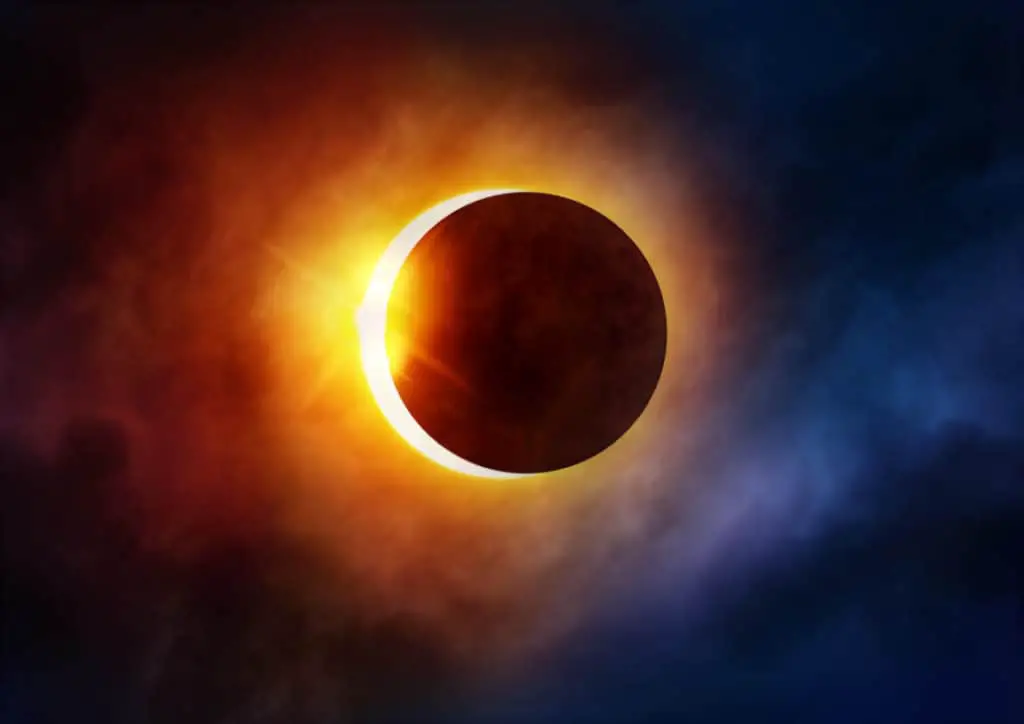
Solar Eclipse Banff – Frequently Asked Questions
What is the safest way to watch the solar eclipse?
To view a solar eclipse safely, always wear protective solar viewing glasses. These shades allow you to look directly at the sun before and after the eclipse’s peak without damaging your eyes.
It’s – probably – safe to view the eclipse during its peak totality (when the sun is wholly obstructed) with the naked eye but use your solar viewing glasses for the rest of the event.
Are there any guided tours or events planned for the solar eclipse in Banff?
Unfortunately, there are no guided tours or events for the solar eclipse in Banff. You might wanna check local event listings in the park for any potential festivities or special programs closer to the eclipse date.
What equipment or eyewear is recommended for watching the solar eclipse in Banff?
As mentioned earlier, using protective solar viewing glasses is crucial for safely observing a solar eclipse. You may also consider bringing binoculars or a telescope to get a closer view of the event. Check that your optical device has proper solar filters to avoid eye damage.
To be safe, you can consult astronomy clubs or experts for recommendations on where to purchase approved eyewear or equipment for eclipse viewing.
What is the difference between a solar eclipse and a lunar eclipse?
A solar eclipse occurs when the moon passes directly between the Earth and the sun, temporarily blocking the sun’s light. In contrast, a lunar eclipse happens when the Earth comes between the sun and the moon, causing the Earth’s shadow to cover the moon’s surface.
While solar eclipses can only be viewed from specific regions during the day, lunar eclipses can be seen by anyone on the nighttime side of the Earth.
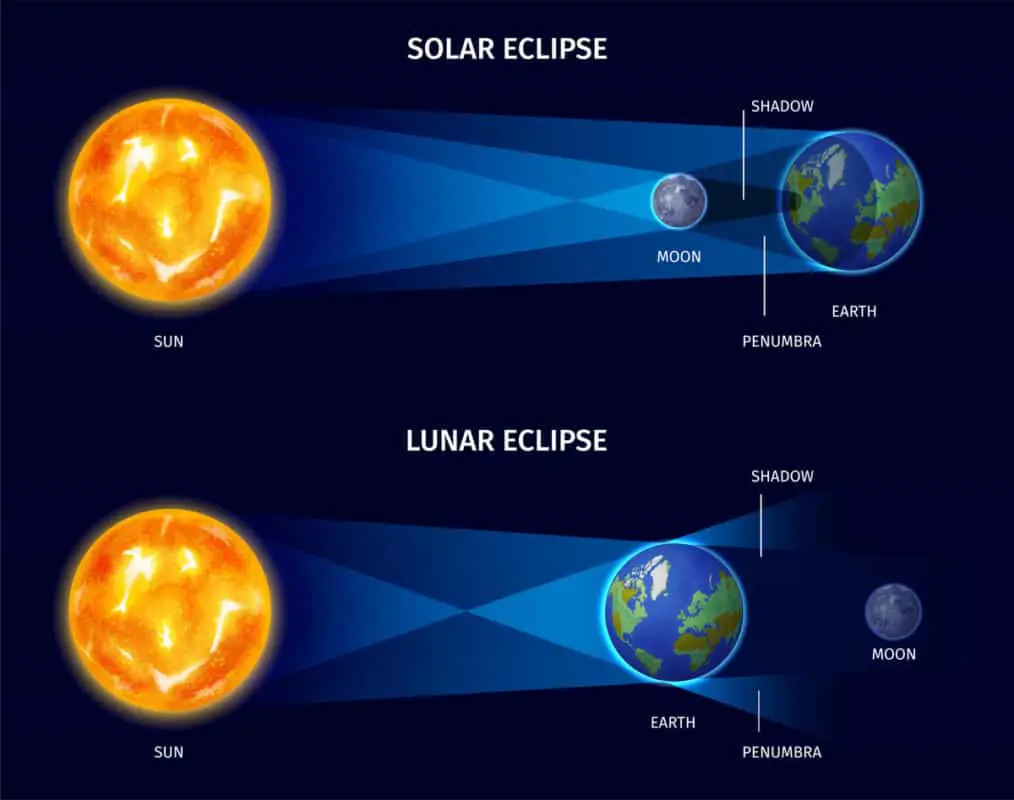
What is the best place to see the 2024 solar eclipse in Canada?
The best place to view the 2024 solar eclipse may vary. It depends on factors such as local weather conditions and the specific path of the eclipse.
You can find detailed information about eclipse visibility for particular locations, such as Eclipses visible in Banff, Alberta, Canada, on websites like timeanddate.com.
As the eclipse date approaches, check local forecast data to know what to wear when watching the eclipse in Canada.
Banff Travel Guide and FAQ
Where is Banff National Park, Canada?
Banff National Park is in the southwest of the province of Alberta. It’s home to the towns of Banff and Lake Louise and borders the province of British Columbia in the west of Canada. You can easily access famous places like Lake Louise, Moraine Lake, Peyto Lake and the stunning Icefields Parkway from these locations.
Banff and Lake Louise are situated in the Rocky Mountains of Alberta, close to the boundary with British Columbia, as shown on the map of Banff National Park below.
Is Banff, Canada safe?
Generally speaking, yes. Like most areas, Banff has crime, but it’s still a safe travel place. But Banff has a lot of wildlife, including bears and cougars, so you should always carry bear spray and exercise caution when hiking in the mountains.
What is the best time to Travel to Banff, Canada?
The best time to travel to Banff, Canada, depends on your reason for visiting the park. If you’re going for the stunning nature the park’s famous for, you’d better visit from June to September. The best months to ski are from January through March.
WEATHER IN BANFF, CANADA: AVERAGE TEMPERATURE

The worst months to visit Banff National Park are November, April and May. It’s too chilly to go sightseeing in November, and there isn’t enough snow on the slopes yet. The iconic lakes in the park are still frozen in April and May, and it can still be quite cold.
How do I travel to Banff, Canada?
Want to fly to Banff? Calgary International Airport (Code: YYC) is the closest airport. It’s 130 kilometers (81 mi) to the east of Banff.
Several cities, including Toronto, Chicago, Seattle, and Dallas/Fort Worth, have direct flights into Calgary.
Pick up a rental vehicle at Calgary International Airport, or take a private transport service to your destination. The trip to the park takes about 1 hour and 40 minutes.
Viator has several good options. Click the link to check the options and latest rates.
Banff Car Rental
Want to rent a car during your stay in Banff National Park? Rent one at Calgary International Airport or in the city of Calgary. Yep, there are rental firms in Lake Louise and Banff, but as these are small towns, your rental options can be limited.
Avis is a reputable car rental company, which I’ve used many times. Book now with Avis
What do I pack for Banff, Canada?
The time of year will affect what you should bring with you on your trip to Banff, Canada. If you plan to spend your summer vacation in Banff National Park, you should be okay with light-colored, breathable clothing. Bring a few sweaters, too, as Banff’s summer evenings can be chilly. You’re in the mountains, after all.
When visiting in winter, bring a heavy jacket, such as a parka, and other winter clothing, such as warm pants, long underwear, and (fleece) sweaters. Don’t take it lightly because Banff’s wintertime lows can reach well below zero.
Banff Travel Planning Guide
Do I need a visa for Banff?
Most likely not. Citizens of the US, most European countries, Australia and New Zealand don’t need a visa to enter Canada. Not sure? Click the link to see whether you need a visa or not. The typical length of stay in Canada for people with visa-exempt passports is 90 days.
Do I need travel insurance for Banff?
You bet. Feel confident while traveling with a plan from Travel Insurance Master, one of the top names in travel insurance, for just USD 10 on average per day.
What’s the best way to book my Banff accommodation?
If you plan to book a hotel, hostel or bed & breakfast, Booking.com is your best bet. It has the most hotels listed and often offers the best rates.
Do I need to rent a car in Banf?
Absolutely. While Banff is one of the few national parks in North America with a sizeable public transport network, I strongly advise renting a car if you want to make the most of your visit.
Will my phone work in Banff?
It depends. In the towns of Banff and Lake Louise, you should have good to excellent reception. However, in more remote areas, the signal is spotty. In many places, there will be no signal at all.
What’s the best site to buy Banff flights?
If you’re looking for cheap flights to Banff, I recommend Skyscanner. No surprises with suddenly increased rates (for taxes, seats or luggage) upon checkout. What you see is what you get.

